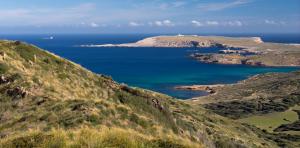
Grants
Renewable Energy
COURE | Creation and promotion of Clean Energy communities in Menorca
16.500€ awarded
TOTAL PROJECT COST – €65,500
IN PROGRESS
- Organisation Applying for Funding: COURE Comunitats en Transició (non-profit consumer and user cooperative)
- Project Duration: 2 years – 2024-2025
- Area of Interest: Renewable Energy
- Other entities involved: Sapiens Energía and Menorca Renovables
THE PROJECT
Primary Impact
Slowing down and adapting to climate change
Summary of the project
The project consists of facilitating the development of Coure, a non-profit cooperative, to create and promote energy communities in Menorca, with two main lines of action:
1. To promote in Sant Climent the first cooperative-based energy community in Menorca, which has been initiated thanks to the collaboration between Coure and the Neighbourhood Association, which will allow the development of collective photovoltaic self-consumption for 9 families and 3 local companies so far.
2. Support Coure’s mission to promote cooperative energy communities in Menorca, providing resources to disseminate and replicate the Sant Climent experience.
Description of the project
Axis 1. Promoting the first cooperative-based energy community in Sant Climent de Menorca.
The creation of an energy community based on collective photovoltaic self-consumption is proposed, as the first experience of a cooperative-based energy community on the island, the consolidation of which will allow its replication in other areas of Menorca. Thanks to the collaboration of the Sant Climent Neighbourhood Association, there is already an initial group of interested people who will become members of the cooperative to jointly finance the development of a collective self-consumption photovoltaic installation on a rooftop in the village. Each participating member will contribute to Coure’s share capital the proportional part of the investment necessary to cover their self-consumption quota, receiving in return the electricity corresponding to their share. All members will benefit from collective self-consumption through the grid with compensation of surpluses.Based on the consumption analysis carried out, an installation has been designed with an initial capacity of 35 kWp, which will generate 51,000 kWh/year for the 9 households (30 people in total, with 17 kWp assigned) and 3 participating companies (with 20 employees and 18 kWp assigned). Once the installation is up and running, Coure will be responsible for the management, monitoring, operation and maintenance of the installation, as well as the management of the energy community.This first model of a cooperative of consumers and users constituted as an energy community in Menorca is intended to be replicated through the financing of the second line of work for which financing is being requested. Coure is in contact with other neighbourhood communities to promote other similar energy communities.
Axis 2. SUPPORTING COURE’S MISSION TO PROMOTE ENERGY COMMUNITIES
To strengthen and expand the Sant Climent model, Axis 2 aims to provide Coure with resources to broaden its social base and replicate the model to create new cooperative-based energy communities. The funds requested will be used to cover the costs associated with the initial definition of the model by Coure, creating management tools, communication and attracting new members through the website and the development of activities that will serve as the basis for the promotion of energy communities similar to the Sant Climent project. This involves common costs for the different energy communities that are created and developed through the Coure cooperative, which also has the support of the Sapiens Energia cooperative.
BENEFITS AND CHARACTERISTICS OF ENERGY COMMUNITIES
Energy communities are entities in which their members obtain, manage and consume their own energy in a sustainable and fair way. This model offers a multitude of advantages for moving towards a socially based energy transition, such as:
● Increasing renewable generation, covering part of the electricity demand that is currently produced mostly in the thermal power plant by means of petroleum derivatives, and therefore reducing emissions.
● Promote a greater culture of cooperation, essential for a true change of energy model, involving citizens in the energy transition in an active way, becoming co-owners of the community’s facilities, participating in decision-making and reducing their dependence on large companies.
● Reversing social and economic benefits of the change of model for the people involved and the local environment.
● To offer the possibility of participating in self-consumption to those who do not have a suitable space to do so individually.
● To generate local electricity, reducing losses in the electricity networks and minimising the impact of intermittent generation in the management of high-voltage networks.
● Facilitating energy training for participants, promoting awareness of the need to change habits to save and reduce consumption.
● To promote the use of useful urban spaces for the installation of photovoltaic panels that would otherwise be underused and reducing the demand for land for the installation of photovoltaic parks on rural land.